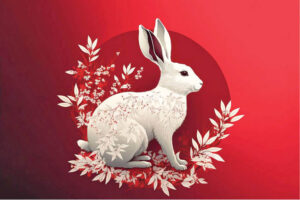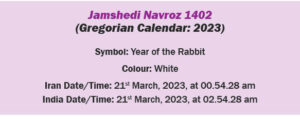 On the 21st March, 2023, our holy Agiaries and Atash Behrams will be resplendently decorated, redolent with torans, as community members will step in to pay their respects to our sacred Atash Padshah, seeking blessings for Jamshedi Navroz. Some, especially those belonging to the Irani faith, will set up the Navroz Haft Seen table, and keep their doors open, welcoming everyone to partake in Navroz treats.
On the 21st March, 2023, our holy Agiaries and Atash Behrams will be resplendently decorated, redolent with torans, as community members will step in to pay their respects to our sacred Atash Padshah, seeking blessings for Jamshedi Navroz. Some, especially those belonging to the Irani faith, will set up the Navroz Haft Seen table, and keep their doors open, welcoming everyone to partake in Navroz treats.
Jamshedi Navroz celebrates the accession to the throne by King Jamshed, the fourth king of the Peshdadian dynasty, whose reign was believed to have been a time of glory, peace and plenty. Celebrating the Spring equinox, when the length of the day and night is equal, the festival of Navroz, literally meaning ‘New Day’, is all about rejuvenation and rebirth, even as nature is bursting with new life after the cold winter months. This wonderful festival that speaks of renewed hope is celebrated in several countries, cutting across barriers of race and religion, and so we find Zoroastrians, Muslims, Ismailis and followers of the Bahá’í faith – all celebrating Navroz. It is this secular nature of the festival that was appreciated and recognized by the UN’s General Assembly, which declared 21st March as the ‘International Day of Nowruz’, in 2010, so that ‘people can promote peace, based on shared values’.
In fact, Navroz shares commonalities with other festivals too! For instance, like it is with the Chinese, every year prior to Navroz, we declare the animal on which the year is based. If fact, it often even coincides with the Chinese animal, and thus, 2023 is the ‘Year of the Rabbit’. One can even draw parallels with the celebration of Easter, where Easter eggs symbolise rebirth and new beginnings and in many Irani households, you will find painted eggs gracing the Haft Seen table, following the same ideology.
There is a great deal of symbolism attached to the festival of Navroz and this is best represented in the Haft Seen table. The traditional Navroz table is an ode to the artistry and aesthetics of the family, as they strive to create the most beautiful and inviting setting while presenting the Haft Seen which translates to seven items that begin with the letter ‘S’. Thus, we have the:
- Seeb (apple), representing beauty;
- Seer (garlic), representing good health;
- Serkeh (vinegar), representing patience;
- Sonbol (hyacinth), representing spring;
- Samanu (sweet pudding), representing fertility;
- Sabzeh (sprouts), representing rebirth; and
- Senjed (lotus tree fruit) representing love.
As a few of these items, which are readily available in Iran, are not available here in India, some Zoroastrian families have their own traditions which have been handed down from generations. Thus on some Navroz tables, one can find Coins – Sekkeh, representing prosperity or a Clock – Saat, symbolising the passage of time. The Avesta may be placed symbolising knowledge and enlightenment. The mirror is also an integral part of the Navroz festival – it represents self-reflection and visitors to the home are traditionally invited to gaze into the mirror. Candles or the ‘divo’ is Shem’a and often, gold fish symbolising progress and painted eggs also find pride of place on a Haft Seen table, representing fertility and rebirth.

Originally, the festival lasts for 13 days and the last day is called, ‘Sizdah-Bedar’, which mean getting ‘rid of the 13’, which is believed to be an unlucky number. Families enjoy picnics in parks and amidst nature before returning to everyday life, after Navroz. In fact, one can draw parallels between this joyous communing with nature on the 13th day with the Japanese tradition of enjoying the blooming of cherry blossoms – the Sakura.
This Navroz, 2023 – the ‘Year of the Rabbit’ – heralds in a year of hope and plenty, as the rabbit is said to symbolise ‘longevity, peace and prosperity’. So, at the time of the vernal equinox, Zoroastrians across the world will light the holy ‘divo’ and pray for divine blessings on their homes and loved ones. It is a joyous time indeed and the feeling of bonhomie will continue for the 13 days of Navroz.
- ‘Celebrating A Life Built On Integrity And Humility’ - 2 November2024
- India Bids Farewell To Her Anmol Ratan - 12 October2024
- A Splendid ‘Parsi Artistry Salon’ By Tinaz Nooshian - 7 September2024
